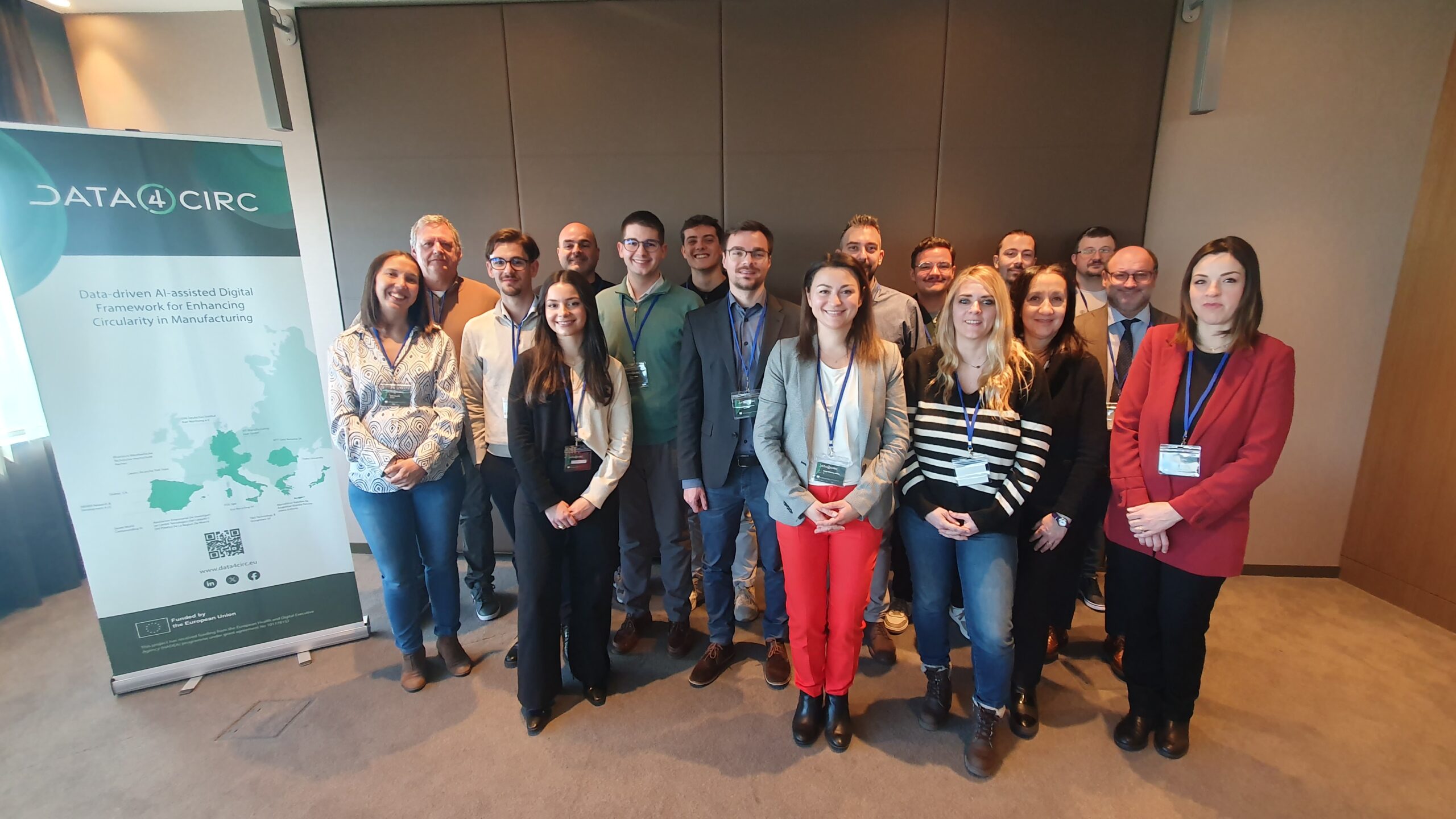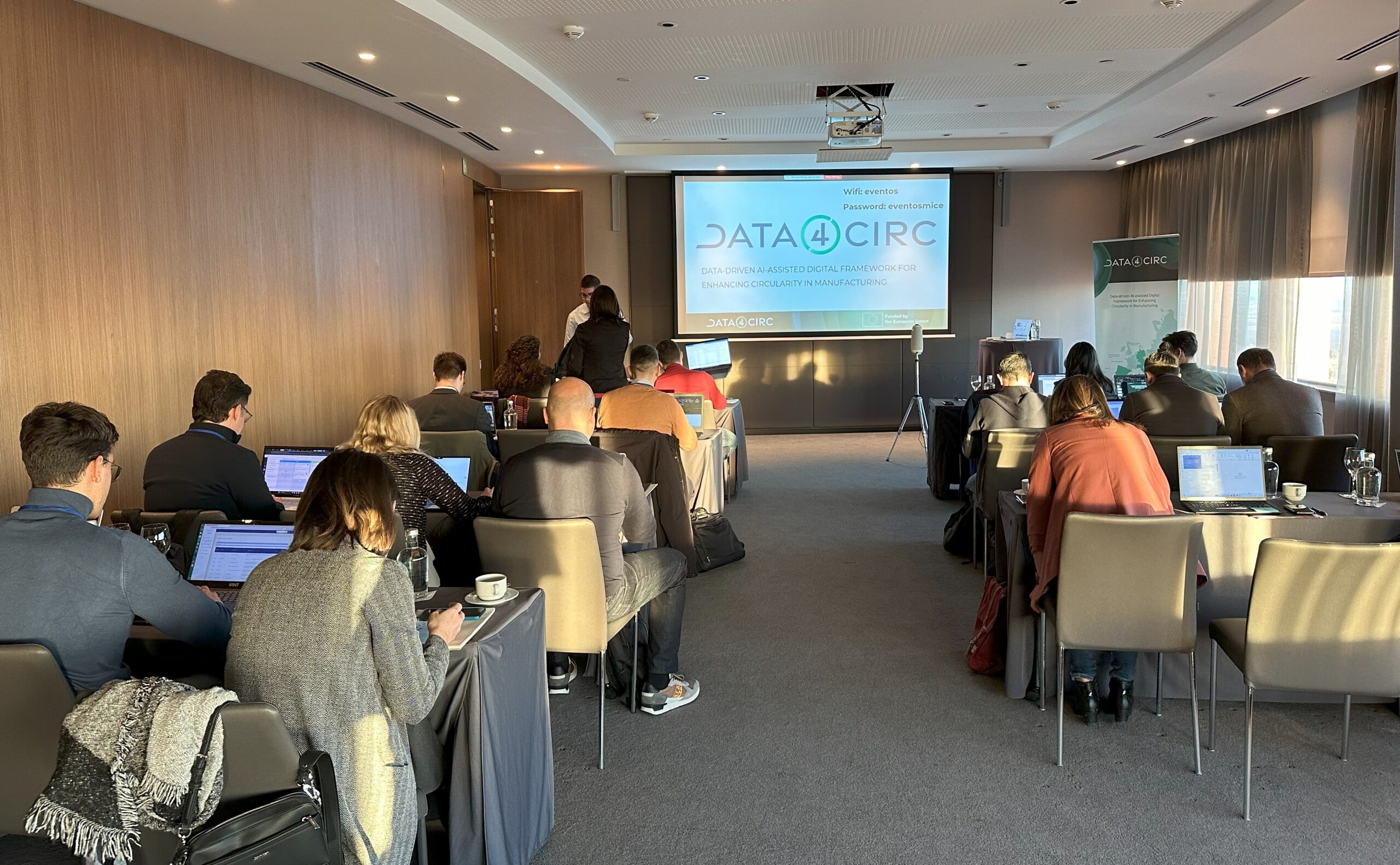Introducing the DATA4CIRC Project
Published May 2025 © DATA4CIRC
Welcome to our first blog post! We’re delighted you’re interested in our project! Read on to find out more about who we are, what we’re doing, why we’re doing it, and how we plan to succeed!
What is the purpose of the DATA4CIRC project?
The European Union has prioritised the shift towards a greener and more sustainable economy. This isn’t just about environmental goals (though they are important): it is also important in terms of future jobs, prosperity, and resilience in Europe. The EU manufacturing sector employs approximately 30 million people; however, recent global events have shown the fragility of global supply chains. Over-dependence on external sources of energy, raw materials, or components, is a potential threat. Manufacturing firms in the EU typically spend 40% of their budgets on materials, so exploiting more circular production processes and improving access to materials can help boost their profitability, and protect them from the price fluctuations caused by armed conflicts, trade wars, or other external events. For this reason, the European Union has set a target of doubling the rate at which materials are recycled or reused by 2030. To help achieve this target, the European Union is investing in research to develop innovative technologies/solutions to support circularity for manufacturing. The Data-driven AI-assisted Digital Framework for Enhancing Circularity in Manufacturing (DATA4CIRC) project was one of seven projects awarded funding to work on:
- Developing new approaches to using Artificial Intelligence to forecast the environmental impact of different products, also considering the quantity and state of those products after their use;
- Developing innovative simulation and modelling software (or build on existing solutions) to foster new manufacturing capabilities with a view to more efficient and more sustainable product design. This optimisation process considers the various steps of the value chain focusing on the environmental impact. Additional ecological impacts arising from the use of the modelling or simulation software is also considered;
- Developing digital platforms/tools built on existing interoperability architectures (such as the Asset Administration Shell), that will enable manufacturers to implement the Digital Product Passport initiative. This focuses on: gathering relevant data; material and product tracking and tracing; and, certification protocols for secure re-used materials and components among sectors;
- Enhancing human involvement in the development of the circularity aspects and new technologies.
Who is behind the DATA4CIRC project?
The DATA4CIRC project, is a 4-year, EU-funded research project that was launched in November 2024 with a budget of €5.6 million. The project is led by Idener.ai, an interdisciplinary Spanish research company specialised in complex AI solutions for engineering and scientific fields. The project consortium is made up of 13 participants from 8 countries, including: Research and Technology Organisations (RTOs); Universities; Small and Medium Enterprises (SMEs); Non-Profit Organisations (NPOs); and a Large Industry Player. The DATA4CIRC project aims to enhance circularity within the manufacturing sector and boost the adoption of R-strategies.

The DATA4CIRC partners at the kick off meeting in Sevilla © DATA4CIRC 2025
What are ‘R-strategies’?
The R-strategies for a circular economy are a series of approaches to minimising waste and maximise resource efficiency. The R-strategies aim to reduce the consumption of raw materials and to keep materials in the production chain for as long as possible, reducing the need for new resource extraction and lessening environmental impact. They range from stopping waste being produced in the first place (e.g. Refuse (to buy) or Rethink (the design of a product)), to utilising materials in new ways (Reuse, Repair, Refurbish, Remanufacture & Repurpose), to extracting value from them at the end of their lifecycles (Recycle & Recover).

The DATA4CIRC Logo © DATA4CIRC 2025
What will be the focus of the DATA4CIRC project?
The DATA4CIRC project will focus on 3 particular use cases: recycling of Agricultural Plastics; recovery of materials from Waste Electrical and Electronic Equipment; and refurbishment of Catalytic Converters in the Automotive Industry.
The DATA4CIRC project is working to develop a platform, comprised of a human-centred, digital framework that will allow data to be collected and, with the aid of cutting-edge digital technology, digitalised and then shared securely, preserving privacy but allowing traceability and lifecycle analysis to assess environmental impacts. The platform will be human-centred in the sense that it will be designed with the end-user in mind, prioritising their needs and ease of use. This will be facilitated through workshops based on each use case, and an upskilling and reskilling training programme. The DATA4CIRC framework can be broken down into 5 key elements:
- A) Federated Data Spaces;
- B) Digital Models;
- C) AI-Assisted End-to-End Lifecycles Analyses;
- D) Digital Product Passports; and
- E) Digitalisation.
Keep an eye out for future blog posts in which we’ll explore these key concepts in more detail!
Bringing all these features together within a single framework is designed to encourage adoption and boost the establishment of circular value chains.

The DATA4CIRC concept © DATA4CIRC 2025
What is the status of the DATA4CIRC project?
At the time of writing (May 2025), DATA4CIRC is still in its early phases – this is the first blog after all! But progress is already being made. The official start of the DATA4CIRC project was in November 2024, following signing of the Grant Agreement and Consortium Agreement, and the project held its first face-to-face meeting in Sevilla in January 2025. This meeting was an excellent opportunity for the partners to develop common visions and deeper understandings of the project and the roles of other teams within it, as each partner presented their role within the project and the key features of the various tasks that will be completed at each stage were explained.
Two days of intensive meetings helped the DATA4CIRC team establish the working procedures for the coming years and some of the key technical ideas were explained in greater detail to the non-technical partners, which was particularly useful in such a complex project! There was also the opportunity to spend some time exploring the wonderful city of Sevilla and sample some of the local cuisine!

The DATA4CIRC team hard at work in Sevilla © DATA4CIRC 2025
We hope you are as excited as we are to follow the DATA4CIRC journey over the next 4 years! You can keep up to date on the latest developments from our project by following us on the DATA4CIRC social media channels:
